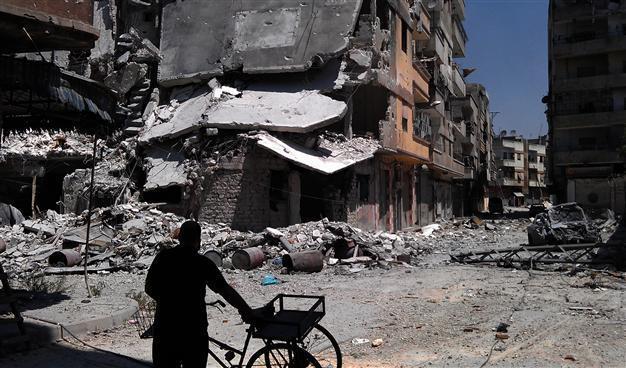Syrian rebels begin evacuation of Homs
HOMS - Agence France-Presse

A man looks at destroyed buildings from Syrian forces shelling in Khaldiyeh, Homs, Syria. AP Photo/Shaam News Network SNN
The evacuation of opposition-held areas of Syria's central Homs city began on May 7 under an unprecedented deal that allows both sides to claim a measure of victory.
After nearly two years of government siege, civilians and rebel forces began to leave the Old City and surrounding areas on buses taking them to opposition territory in northern Homs province.
Their departure saves both sides the prospect of a drawn-out, potentially devastating battle, and allows rebels to leave with some weapons.
But the deal also effectively turns over the city once dubbed the "capital of the revolution" to government control.
The evacuation began around 10:00 a.m. local time, with three buses carrying civilians and fighters departing the devastated Old City.
"Three buses have left, carrying 120 people in total, a mixture of wounded and non-wounded civilians and fighters," rebel negotiator Abul Hareth al-Khalidi told AFP via the Internet.
A video posted online by opposition activists showed a group of fighters, some with their faces covered with black or white scarves, walking in a line towards green buses.
They carried backpacks and light weapons as they boarded the buses, watched by regime police forces and accompanied by a white U.N. car.
Around an hour after the operation began, Khalidi said a first bus had arrived in the north of the province. The evacuees are being transferred to the rebel-held town of Dar al-Kebira, 20 kilometers from Homs.
Tens of thousands under siegeThe deal between the regime and rebels, mediated by Iran's ambassador to Syria, was reached as part of an exchange for a number of hostages being held by opposition fighters in the northern city of Aleppo.
Under the agreement, fighters will also allow aid into two Shiite majority towns in the same province, Nubol and Zahraa, where some 45,000 people are under rebel siege.
It was not immediately clear whether aid had begun entering the towns, but the Syrian Observatory for Human Rights said roads into the two communities had been prepared for deliveries to begin.
Once the Homs operation is complete, the evacuated areas are to be turned over to the government, which is expected to send in forces to sweep for mines and explosives. The regime will then have control of all but one major area of Homs city.
While the area being reclaimed by the government is relatively small, it retains huge symbolic importance for the opposition. In the beginning of Syria's uprising, Homs came to be known as the "capital of the revolution" because of the size and vigour of the anti-government protest movement there.
Near-daily bombardment and fighting have left much of the Old City in ruins, with homes, building and religious sites destroyed.
During the nearly two-year government siege, which left around 3,000 people trapped, food and medical supplies dwindled and there were repeated calls for a plan to evacuate civilians.
In February, a U.N.-Red Crescent operation successfully evacuated around 1,400 people, and delivered limited aid to the besieged areas.
But hundreds of fighters and wounded people unable to make it to evacuation points were left behind, and their situation worsened as the government launched an assault on the besieged areas last month.
